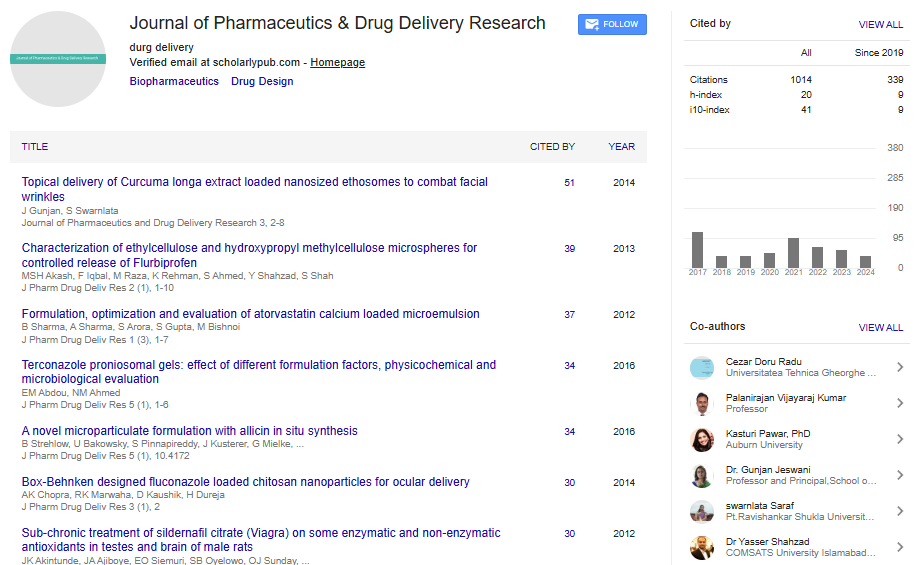Opinion Article, J Pharm Drug Deliv Res Vol: 13 Issue: 4
Recognizing Contraindications: Ensuring Patient Safety in Drug Treatment
Thilak Mudalige*
1Department of Pharmaceutical Science, Aarhus University, Aarhus, Denmark
*Corresponding Author: Thilak Mudalige,
Department of Pharmaceutical Science,
Aarhus University, Aarhus, Denmark
E-mail: mudaliget67@gmail.com
Received date: 01 July, 2024, Manuscript No. JPDDR-24-145763;
Editor assigned date: 03 July, 2024, PreQC No. JPDDR-24-145763 (PQ);
Reviewed date: 17 July, 2024, QC No. JPDDR-24-145763;
Revised date: 24 July, 2024, Manuscript No. JPDDR-24-145763 (R);
Published date: 31 July, 2024, DOI: 10.4172/2325-9604.1000292
Citation: Mudalige T, (2024) Recognizing Contraindications:Ensuring Patient Safety in Drug Treatment. J Pharm Drug Deliv Res 13:4.
Description
In the territory of pharmacotherapy, ensuring patient safety is paramount. One of the precarious aspects of this process is understanding and adhering to contraindications specific situations where a drug or treatment should not be used because it could cause harm. Contraindications play a vital role in guiding healthcare professionals to make informed decisions, thus preventing adverse drug reactions and safeguarding patient well-being.
Defining contraindications
Contraindications are conditions or factors that serve as red flags, indicating that a particular drug or treatment could be harmful to a patient. They are typically categorized into two main types: Absolute and relative contraindications.
Absolute contraindications: These are situations where a drug or treatment must be avoided entirely. For instance, the use of isotretinoin (a medication for severe acne) during pregnancy is absolutely contraindicated due to its high risk of causing severe birth defects. In such cases, the potential risks far outweigh any possible benefits and the medication should never be administered.
Relative contraindications: These are conditions where a drug or treatment should be used with caution, or only when no safer alternative is available. For example, beta-blockers, commonly prescribed for hypertension, are relatively contraindicated in patients with asthma. While they can be used in such patients, it requires careful monitoring and consideration of potential risks.
The importance of identifying contraindications
Patient safety: The primary goal of recognizing contraindications is to prevent harm. By identifying situations where a drug could be dangerous, healthcare providers can avoid adverse drug reactions, which can range from mild side effects to life-threatening complications.
Personalized treatment: Contraindications are a key component of personalized medicine. By understanding a patient's medical history, comorbidities and other factors, healthcare providers can tailor treatments to the individual, ensuring that they receive the safest and most effective care possible.
Legal and ethical responsibility: Adhering to contraindications is not just a medical necessity but also a legal and ethical obligation. Prescribing a medication in the presence of a known contraindication can lead to malpractice claims and damage to the healthcare provider’s professional reputation.
Common contraindications in clinical practice
Pregnancy: Many medications are contraindicated during pregnancy due to the potential for harm to the developing fetus. Drugs like warfarin, ACE inhibitors and certain antibiotics fall into this category.
Allergies: Patients with known allergies to specific drugs, such as penicillin, should avoid those medications. An allergic reaction can range from mild rash to severe anaphylaxis, which can be lifethreatening.
Chronic conditions: Certain chronic conditions, like liver or kidney disease, may contraindicate the use of specific drugs. For example, Nonsteroidal Anti-Inflammatory Drugs (NSAIDs) are often contraindicated in patients with renal impairment due to the risk of worsening kidney function.
Challenges in managing contraindications
Despite their importance, managing contraindications can be challenging. The complexity of modern medicine, with its plethora of drugs and treatment options, requires healthcare providers to stay informed about the latest guidelines and potential interactions. Additionally, individual patient factors, such as genetics and comorbidities, can further complicate decision-making.
To address these challenges, healthcare providers often rely on Electronic Health Records (EHRs) and Clinical Decision Support Systems (CDSS), which can flag potential contraindications and suggest alternative treatments. Continuing education and interdisciplinary collaboration also play a vital role in ensuring that contraindications are properly managed.
 Spanish
Spanish  Chinese
Chinese  Russian
Russian  German
German  French
French  Japanese
Japanese  Portuguese
Portuguese  Hindi
Hindi 
